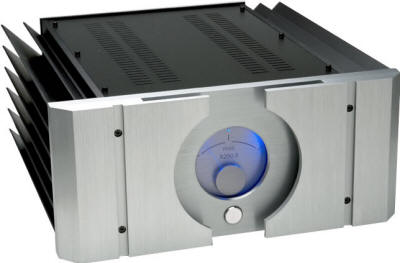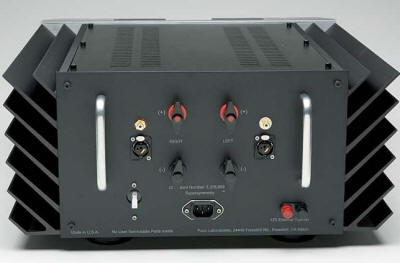The Pass Labs X250.5 stereo power amplifier may very well be the world’s best 15 Watt per channel stereo amplifier. Even though the amplifier is rated as 250 Watts per channel, it runs in Class A mode up to 15 Watts, then shifts gears into Class AB for the remainder of the power rating. It is easy to both hear the shift and see the shift. When the front panel bias meter starts to boogie with the music, we have left the sanctuary of Class A. Let me suggest that we consider this amplifier a Class A, 15 Watt per channel amplifier with lots of headroom. With that understanding, we can discuss this very fine amplifier.

The main comparison amplifier during the audition period, which lasted for several months, was the exceptional Manley Neo-Classic 250. The Manley is an all tube monoblock amplifier that uses ten EL34 tubes for the output stage. If you are thinking that because the Manley has EL34s, it sounds warm and rich and soft and rolled off, you are only partly correct. It does indeed sound warm and rich, but definitely not soft and rolled off. The bass is powerful and goes very deep, and the highs are extended and clear. It is one of the very best amplifiers I have had in my room, and always offers music in an involving manner. Other amplifiers included the BAT VK-220 and VK-250SE, and Halcro MC20. Loudspeakers are mostly the superb stand-mounted Dali Euphonia RS3 with help in the bass from a pair of either my Perfect Subs or JL Audio Fathom f112s. I also brought in the Dali Mentor 5 floor standers from the HT system to hear the Pass amp on a more full-range speaker system.
The $8,250 Pass Labs X250.5 amplifier was run balanced from my heavily modified Audio Research LS22 preamplifier. In this system, the X250.5 performed splendidly. The bass as a separate entity simply disappeared. It was powerful and dynamic enough, detailed enough, tight and fast enough. And enough was truly excellent because while the bass was fully apparent, it was never too much nor too little of anything that could intrude on the overall presentation.
The upper frequencies were equally well served by this hot running amplifier. (Side note: I don’t understand those horizontally mounted heat sinks. Hot air rises, as in vertically.) The Manley amps have a bit more depth into each note which offers a better understanding of the mood and nuances of a performance. The Pass Labs amp does a fine job, however, by not harming the upper midrange and treble with any hint of harshness or glare. I suspect this performance character will appeal more to toe-tappers, who like to get physical with their music. You eye-closers, who enjoy internalizing the performance, will find times of great satisfaction, too. There is similar clarity to some 6550 tube amplifiers. The upper frequencies are clear and clean while missing a bit of the resonant depth of the EL34 Manleys.
The leading edge of notes, which launch each musical event, was always very well defined without ever sounding sharp or hard. The sounds of the plucking of guitar, or tapping a cymbal, or a strike on a drum were always very realistic. The wood sticks sound stunningly real at the beginning of “Everything Gives You Cancer”, on Joe Jackson’s Night & Day LP. This naturalness is just one example of the “virtual reality” experience we all want from our audio systems and which is a common feature of listening to the X250.5. One of the strengths of this amplifier is while leading edge detail and speed was never wanting, it never accentuated the clicks and pops on long playing records.

The soundstage is very well defined left to right and front to back. Singers have an exact point in space for the ultimate in pinpoint imaging. There is an excellent sense of the space and the size of each instrument. In “The Race”, from the Yello LP Flag, the localization and easy ability to look directly at the source of the sound is showcased. It is amazing to watch the race car driving across the front of my listening room. This is not only between the speakers, but far to the left and right of the speaker boundaries. The sound of the moving car forced my eyes to follow the apparent movement of the car’s high-revving engine. The X250.5 presented the deepest soundstage I have yet heard in my room. Even though the rear wall – behind the speakers – didn’t quite melt away, it was definitely losing its solidity and becoming hazy. Musicians seemed to be on their own stage, in a slightly different acoustic environment than the listening room’s own acoustic space. I usually hear the performance in its own venue, or the musicians come into my space. I have never heard this duality effect before the Pass X250.5 amplifier came to visit.
Another good example of the soundstaging prowess of the X250.5 is in Sting’s “They Dance Alone” from the excellent double-LP Nothing Like the Sun. The projected venue is a mid-size recording studio. Listening to the same cut on the Manley amps, the recording seems to have been made in a larger rehearsal hall that could hold a hundred seats. The air seems just a bit denser and more alive with the Pass Labs amplifier.
This amplifier made me seriously question the rightness of tube sound, which many listeners feel is truer to the sound of live instruments. Many times during the audition, I heard certain instruments – brass and percussion especially – that sounded exactly the way they do in concert. Long term listening is a continual pleasure. Night after night for hours at a time, I looked forward to every opportunity to hear my favorite music through the Pass Labs X250.5 amp. The frequency balance is perfect. No particular range, narrow or wide, stands out and screams “great bass”, or listen to this “transparent” treble. There is an integrated wholeness to the entire audible range that is very natural and easy to enjoy. The Pass Labs amplifier can approach the harmonic depth of the Manley at lower volumes. Just keep the bias needle within one needle-width of idle or the easy musicality will fail and the amplifier sounds like many other mid-priced Class AB products – somewhat unfocused and coarse, with an obvious layer of fine grain. At higher power levels, the X250.5 and BAT VK-250SE are directly comparable.
Within its Class A power limits, this amplifier offers great focus and warmth when the recording includes those attributes. Think of the X250.5 as a delightful 15 Watt per channel amp with huge headroom and not as a 250 Watt freight train that sounds better running light. I thought about replacing the Manley amps with a pair of Pass Labs’ XA100.5 amps, which are 100 Watt pure Class A at $16,500 per pair. Their cost and power requirements, which might have exceeded my listening room’s 20 Amp supply, nixed that option. If 15 Watts per channel is enough for your system, the Pass Labs X250.5 might be a viable alternative to that low power amp with the expensive tubes. As good as this amplifier is within its pure Class A power limits, the rating below is for the specified 250 Watt per channel product.
Overall Rating: 8.5 LPs
Link to Pass Labs
